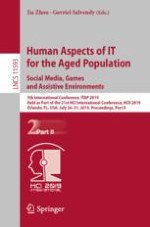2019 | Buch
Human Aspects of IT for the Aged Population. Social Media, Games and Assistive Environments
5th International Conference, ITAP 2019, Held as Part of the 21st HCI International Conference, HCII 2019, Orlando, FL, USA, July 26-31, 2019, Proceedings, Part II
herausgegeben von: Dr. Jia Zhou, Prof. Gavriel Salvendy
Verlag: Springer International Publishing
Buchreihe : Lecture Notes in Computer Science
